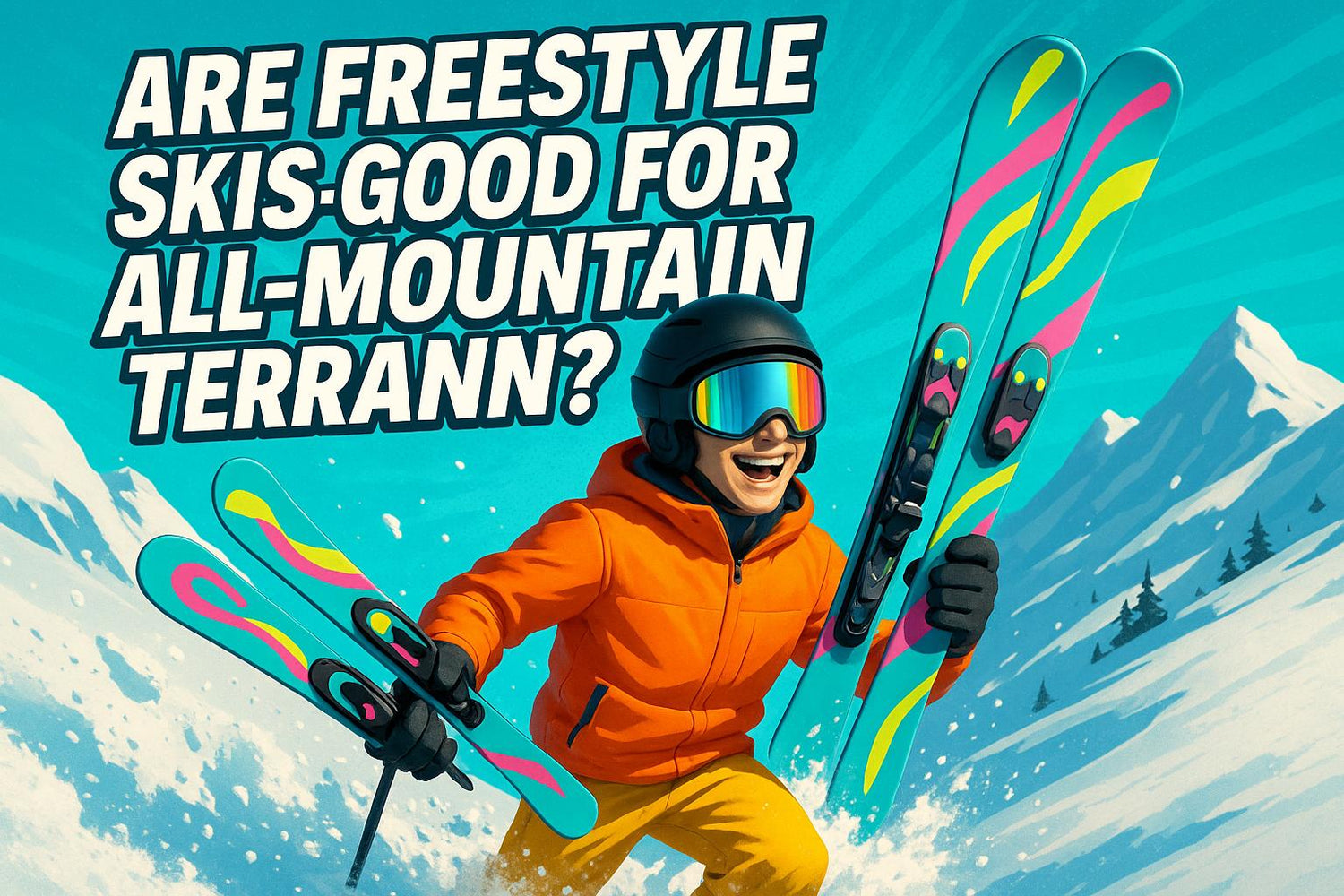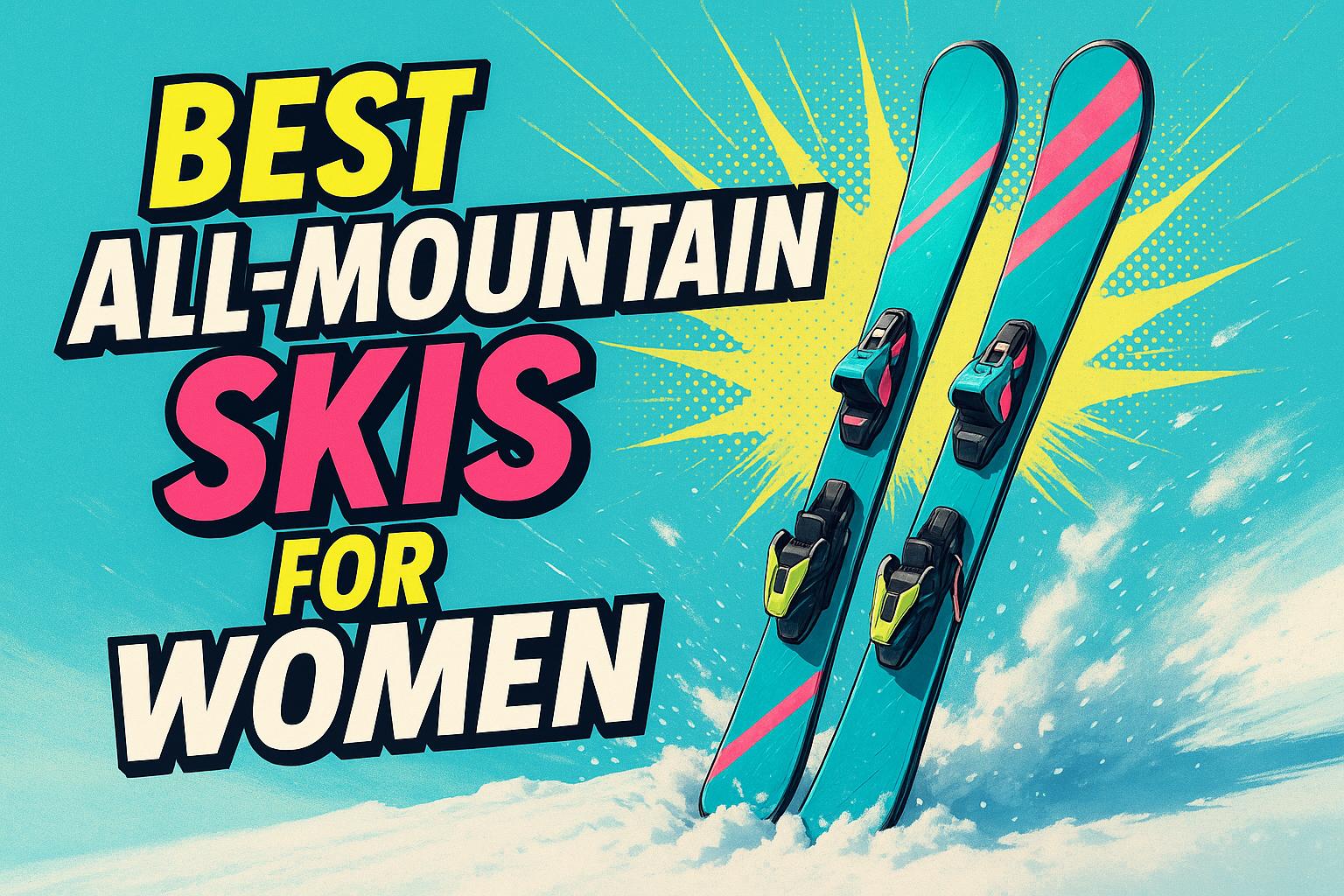フリースタイルスキーがオールマウンテンの地形に対応できるか気になるなら、簡単な答えは:はい、でも何を求めるかによります。特に短めのSnowfeet*モデルは、機敏さ、使いやすさ、そして比類なき携帯性を提供します。一方、RossignolやSalomonのようなブランドの長めのオールマウンテンスキーは速度と安定性に優れていますが、カジュアルスキーヤーには扱いが難しいこともあります。
簡単にまとめると:
- Snowfeet* フリースタイルスキー:コンパクトで軽量(一部はバックパックにも入る)、タイトなターンやモーグル、混合地形に最適。初心者や利便性を重視する人にぴったりです。
- オールマウンテンスキー:長くて重く、高速でのコントロールや深いPOWDERでの性能に優れています。整地されたコースでの精密な滑りを求める経験者に最適です。
結論:携帯性と使いやすさを重視するなら、Snowfeet*のフリースタイルスキーは楽しく手間いらずの選択肢です。高速性能や深いPOWDERを求めるなら、長めのオールマウンテンスキーを選びましょう。
2020年 メンズ ツインチップ フリースタイル&オールマウンテンスキー比較
1. Snowfeet* フリースタイルスキー

Snowfeet*は、フリースタイルスキーがオールマウンテンの地形で何ができるかの常識を覆しました。彼らのラインナップはスキーの長さと性能の常識に挑戦し、コンパクトな38cm Mini Ski Skates(150ドル)、99cm Skiblades(490ドル)、そして120cm Short Skis(690ドル)などの選択肢を提供します。これらは単なるパーク用ではなく、どこでもパフォーマンスを発揮するよう設計されています。
操作性
短いスキーは操作が簡単で、Snowfeet*はその利点を最大限に活かしています。例えば、99cmのSkibladesは、素早く正確な切り替えを可能にし、モーグルも楽々です。従来のスキーはターンにより多くの脚力を必要としますが、これらはわずかな体重移動にも即座に反応します。
この機敏さは、狭いツリーランや混雑したゲレンデで輝きます。65cmのSkibladesは、スキーのテールが障害物や他のスキーヤーに引っかかる心配なく、鋭く素早いターンをするのに最適です。機敏でコントロールされた動きを可能にし、難しい場所も楽にナビゲートできます。
安定性
驚きなのは、短いスキーでも安定できることです。Snowfeet*はスキーを低重心で設計しており、多くのスキーヤーがバランスを保ちやすくなっています。例えば120cmのショートスキーは、木製コア構造と緻密なデザインのおかげで、高速でも安定感があります。
違いはこれらのスキーが力をどう扱うかにあります。170cmの長いスキーのレバーアームと格闘する代わりに、中心に留まりコントロールを保てます。これは長いスキーが身体的に負担に感じるかもしれない中級スキーヤーにとって素晴らしい選択肢です。
携帯性
ここでSnowfeet*が真に際立ちます。ミニスキースケートは非常にコンパクトでバックパックにすっぽり収まります。大きすぎる手荷物料金や長いスキーを不格好に運ぶことは忘れてください—これらは思い立ったらすぐの山の旅に最適です。
旅行者にとってはゲームチェンジャーです。リモートのスキー場や未踏のPOWDERに簡単に持ち運べ、汗をかくこともありません。バックパックに固定して目的地までハイキングすれば準備完了—伝統的な長いスキーではできないことです。
地形でのパフォーマンス
Snowfeet*スキーは山が何を投げかけても対応できるように作られています。99cmのPOWDERモデルは新雪で力を発揮し、標準のSkibladesは整備されたコースでスムーズにカービングします。
地形が朝は氷、昼はPOWDER、午後はクラッドと変化する日でも、これらのスキーは簡単に適応します。長いスキーのターン半径や速度制限に縛られることはありません。朝はパークのフィーチャーを楽しみ、その後は同じギアで整備されたコースをクルーズできます。
さらに、これらのスキーは通常の冬用シューズ、スノーボードブーツ、またはスキーブーツと互換性があり、さらに多用途です。スキーからハイキングや、伝統的なスキーブーツでは難しいエリアの探検に簡単に切り替えられます。
2. 標準的なオールマウンテンスキー
Rossignol、Salomon、そしてK2のようなブランドの伝統的なオールマウンテンスキーは、長年にわたりゲレンデの定番でした。これらのスキーはSnowfeet*スキーと比べて長くて高価ですが、Snowfeet*は機敏さと多用途性に焦点を当てています。伝統的なスキーは特定の条件下で強みを持ちますが、Snowfeet*の革新的なデザインと比べるといくつかの顕著な制限があります。
操作性
長いスキーはターンにより多くの努力を要します。強い脚力と正確な体重移動が必要で、モーグルや狭いスペースのナビゲートが難しくなります。さらに、設計上ターン半径が広くなるため、各ターンにより多くのスペースが必要です。初心者にとっては厳しく感じられ、山での一日がより疲れやすくなることがあります。
安定性
伝統的なスキーは整備されたコースでの高速安定性に優れています。長いエッジがしっかりとしたグリップを生み、特に急なトレイルで効果的です。しかし、トレードオフとして、長さが重心を高くし、中級者にとってバランスが難しくなります。予測できない状況では、小さなミスが大きく響き、コントロールを失いやすくなるかもしれません。
携帯性
伝統的なスキーの大きな欠点は携帯性です。サイズと重量が旅行やバックカントリースポットへのハイキング時に手間となります。かさばるギアを持ち運ぶのは、遠隔のトレイルに向かう時やシンプルにしたい時には理想的ではありません。
地形でのパフォーマンス
伝統的なオールマウンテンスキーは、深いPOWDERでのしっかりとした浮力や整備されたトレイルでの安定したコントロールなど、特定のシナリオで優れた性能を発揮します。しかし、雪の質が変わると—例えば氷のパッチから新雪へ—適応力が低く感じることがあります。専用のブーツが必要で習得の難易度も高いため、オールマウンテンツーリングとフリースタイル要素を組み合わせたいスキーヤーには最適でないかもしれません。
sbb-itb-17ade95
長所と短所
Snowfeet* フリースタイルスキーと伝統的なオールマウンテンスキーの主な特徴を分解して、どちらがあなたのスタイルに合うかを判断しましょう。
Snowfeet* フリースタイルスキーは携帯性と動きやすさで輝きます。ペアで約5ポンド(2.27 kg)と軽量で、バックパックに入れて持ち運べるため、隠れたスポットへのハイキングに最適です。コンパクトなサイズなので、かさばるルーフラックともお別れできます。ゲレンデでは短い長さが素早いターンを簡単にし、長時間の滑走でも疲労を軽減します。
一方で、伝統的なスキーは高速での安定性や深いPOWDERの扱いにおいて優れています。整備されたコースでの精密な滑走を求めるスキーヤー向けに作られており、身体的な要求や習得の難しさにも対応できます。しかし、そのサイズと重量は持ち運びに少し手間がかかることがあります。
| 特徴 | Snowfeet* フリースタイルスキー | 伝統的なオールマウンテンスキー |
|---|---|---|
| 操作性 | 狭いスペースや素早く簡単なターンに最適 | より広いターンと高度な技術が必要 |
| 安定性 | 中速でのしっかりとしたコントロール、初心者に優しい | 高速での優れた安定性とより良いエッジグリップ |
| 携帯性 | 超軽量(ペアで約5ポンド)、バックパックに収まる | 大きくて重く、持ち運びが難しい |
| 地形でのパフォーマンス | さまざまな条件でよく機能する | 深いPOWDERや整地されたコースで優れる |
| 習得曲線 | 簡単に始められ、直感的な操作 | 習得にはより多くの時間と技術が必要 |
利便性、多用途性、使いやすさを重視するなら、Snowfeet* フリースタイルスキーは堅実な選択です。かさばるギアの煩わしさなしに探検したいレクリエーションスキーヤーに最適です。ただし、高速パフォーマンスや特定の条件の習得を優先し、技術的な挑戦に対応する準備があるなら、伝統的なスキーの方があなたのスピードに合っているかもしれません。
ほとんどのカジュアルスキーヤーにとって、Snowfeet* は楽しく、携帯性が高く、柔軟な代替手段を提供し、山を楽しむ新しい方法を開きます。
結論
フリースタイルと伝統的なオールマウンテンスキーの違いを掘り下げた後、明らかなことは一つ:あなたの選択は何を優先するか、つまり携帯性、使いやすさ、またはパフォーマンスにかかっているということです。
Snowfeet* 製品はカジュアルスキーヤーや初心者に特に際立っています。超携帯性のデザインで遠隔地へのアクセスも簡単で、直感的な操作性が習得のハードルを下げ、初心者や利便性を求める方に最適な選択肢となっています。
伝統的なスキーは、高速カービングや深いPOWDERの攻略において依然として強みを持っています。Rossignol、Salomon、K2のようなブランドは、特に急斜面の整地されたコースで信頼できる安定性を長年提供してきました。しかし、Snowfeet* は長いスキーが常に優れているという古い考えを覆します。65 cm、99 cm、120 cmの長さで、オールマウンテンのスキーの意味を再定義しています。そのコンパクトなデザインは持ち運びを容易にするだけでなく、レクリエーションスキーヤーの斜面体験を変えます。
つまり、フリースタイルスキーがオールマウンテンの地形に対応できるかどうかではなく、平均的なスキーヤーにとって伝統的なスキーがその追加の努力に見合うかどうかが問題です。機動性と携帯性を求めるなら、Snowfeet* フリースタイルスキーは山での利便性と楽しさを新たなレベルに引き上げます。
技術的な精度よりもシンプルさと楽しさを重視する方には、Snowfeet* フリースタイルスキーが他に負けないオールマウンテン体験を提供します。
よくある質問
Snowfeet* フリースタイルスキーは、伝統的なスキーと比べてオールマウンテンスキーに適していますか?
Snowfeet* フリースタイルスキーは、オールマウンテンスキーに新たな楽しさと柔軟性をもたらします。軽量でコンパクトなサイズ(65 cm、99 cm、120 cm)が揃っており、扱いやすさは抜群です。POWDERを切り裂いたり、シャーベット状の斜面を乗り越えたり、パークでフリースタイルアクションを楽しんだりと、そのデザインは素早いターンと遊び心あふれるライディングを簡単にします。これは伝統的な長いスキーではなかなか実現しにくいことです。
これらのスキーを本当に際立たせているのは、リバースキャンバーテクノロジーで、整備されたトレイルでもバックカントリーの冒険でもスムーズなパフォーマンスを保証します。従来のオールマウンテンスキーは高速での安定性を提供するかもしれませんが、Snowfeet*スキーは適応性と携帯性に優れています。様々な地形で使えるダイナミックで使いやすいオプションを求めるスキーヤーにとって素晴らしい選択です。
Snowfeet*フリースタイルスキーは、スピードとコントロールを求める上級スキーヤーにとって良い選択肢ですか?
Snowfeet*フリースタイルスキー、例えばSnowfeet PROや120 cm Skibladesは、敏捷性、コントロール、そして斜面での大いなる楽しさを求める上級スキーヤーにとってゲームチェンジャーです。高速安定性と結びつけられがちな従来の長いスキーとは異なり、Snowfeet*はコンパクトで軽量なデザインで新たな展開を見せます。このセットアップは操作性を高めつつ、パフォーマンスも十分に発揮します。
これらのショートスキーは、精度と適応性を重視するスキーヤーにとって夢のような存在です。整備されたトレイルを滑り抜けたり、POWDERに挑んだり、パークのフィーチャーを楽しんだりする時も、Snowfeet*は遊び心がありながら安定した乗り心地を提供します — スピードを上げても安心です。山を全く新しい方法で探検したいスキーヤーにとって新鮮な選択肢です。
なぜSnowfeet*フリースタイルスキーは、旅行や未踏のスキーエリアの探検に最適な選択肢なのでしょうか?
Snowfeet*フリースタイルスキーは、未踏のスキー場を探検するのが好きな人にとって素晴らしい選択肢です。コンパクトで軽量な作りのおかげで、バックカントリーへのハイキングや狭いトレイルの通過もとても楽に持ち運べます。従来のスキーやかさばるスノーボードとは違い、これらはあなたの冒険的なライフスタイルにぴったりフィットし、重いギアを持ち歩くことなく自由に動き回れます。
本当に彼らを際立たせているのは、多用途性とコントロールです。彼らはプロのように様々な地形をこなします - 整備された斜面、新鮮なPOWDER、そしてあの難しい森の小道さえも。未踏の雪をカービングしたり、狭いトレイルをナビゲートしたりする時も、Snowfeet*スキーは制限なく探検する自由を与えてくれます。さらに、その小さなサイズはパッキングを簡単にし、軽装で旅を楽しみ、楽しさに集中できます。利便性、機動性、そして山でのちょっとした即興を大切にする人にぴったりです!


































コメントを残す
このサイトはhCaptchaによって保護されており、hCaptchaプライバシーポリシーおよび利用規約が適用されます。